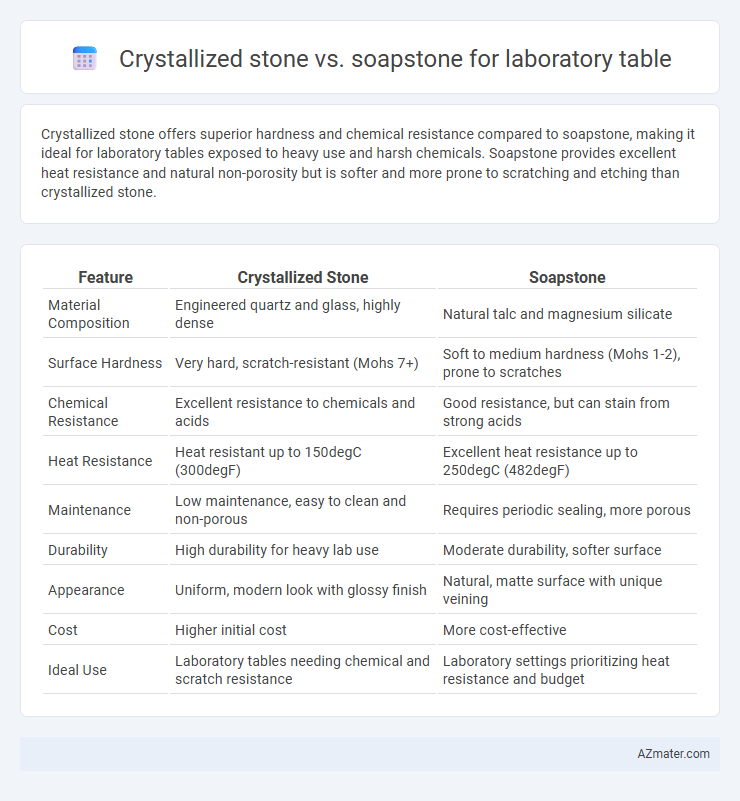Crystallized stone offers superior hardness and chemical resistance compared to soapstone, making it ideal for laboratory tables exposed to heavy use and harsh chemicals. Soapstone provides excellent heat resistance and natural non-porosity but is softer and more prone to scratching and etching than crystallized stone.
Table of Comparison
| Feature | Crystallized Stone | Soapstone |
|---|---|---|
| Material Composition | Engineered quartz and glass, highly dense | Natural talc and magnesium silicate |
| Surface Hardness | Very hard, scratch-resistant (Mohs 7+) | Soft to medium hardness (Mohs 1-2), prone to scratches |
| Chemical Resistance | Excellent resistance to chemicals and acids | Good resistance, but can stain from strong acids |
| Heat Resistance | Heat resistant up to 150degC (300degF) | Excellent heat resistance up to 250degC (482degF) |
| Maintenance | Low maintenance, easy to clean and non-porous | Requires periodic sealing, more porous |
| Durability | High durability for heavy lab use | Moderate durability, softer surface |
| Appearance | Uniform, modern look with glossy finish | Natural, matte surface with unique veining |
| Cost | Higher initial cost | More cost-effective |
| Ideal Use | Laboratory tables needing chemical and scratch resistance | Laboratory settings prioritizing heat resistance and budget |
Introduction to Laboratory Table Materials
Crystallized stone and soapstone serve as popular materials for laboratory tables due to their durability and chemical resistance. Crystallized stone offers superior scratch resistance and a sleek, polished surface ideal for modern lab environments. Soapstone excels in heat resistance and natural non-porous properties, making it highly effective for handling corrosive substances and temperature fluctuations.
Overview of Crystallized Stone
Crystallized stone is an engineered material composed primarily of natural quartz crystals fused with resins and pigments, offering superior hardness and chemical resistance ideal for laboratory tables. Its non-porous surface prevents absorption of chemicals, making it highly durable and easy to maintain in harsh lab environments. Unlike soapstone, crystallized stone provides enhanced scratch resistance and a wider range of aesthetic finishes while maintaining excellent thermal stability.
Overview of Soapstone
Soapstone is a natural metamorphic rock primarily composed of talc, known for its excellent heat resistance and chemical stability, making it an ideal choice for laboratory tables. Its non-porous surface prevents absorption of chemicals and stains, ensuring durability and easy maintenance in a lab environment. Compared to crystallized stone, soapstone offers superior resistance to acids and solvents, which enhances its longevity under rigorous laboratory conditions.
Durability Comparison: Crystallized Stone vs Soapstone
Crystallized stone offers superior durability compared to soapstone, boasting higher resistance to scratches, acids, and chemical spills commonly encountered in laboratory settings. Soapstone, while naturally heat-resistant and chemically inert, is softer and more prone to surface damage and wear over time. Choosing crystallized stone ensures longer-lasting laboratory tables that maintain structural integrity and appearance under rigorous use.
Chemical Resistance: Which Material Performs Better?
Crystallized stone exhibits superior chemical resistance compared to soapstone, making it more suitable for laboratory tables exposed to harsh chemicals, acids, and solvents. Its non-porous surface resists staining and corrosion, ensuring durability and easy maintenance in demanding environments. Soapstone, while moderately resistant to many chemicals, is softer and more prone to etching and damage from strong acids, reducing its overall longevity in laboratories.
Heat Resistance in Laboratory Environments
Crystallized stone offers exceptional heat resistance withstanding temperatures up to 1200degF, making it ideal for laboratory tables exposed to intense thermal conditions. Soapstone, while naturally heat-resistant up to around 600degF, provides adequate protection for moderate heat applications but may degrade under prolonged high temperatures. Choosing crystallized stone ensures superior durability and maintains surface integrity in laboratories utilizing high-heat experiments and equipment.
Maintenance and Cleaning Requirements
Crystallized stone laboratory tables require minimal maintenance due to their high resistance to stains, scratches, and chemicals, allowing for easy cleaning with mild detergents and water. Soapstone surfaces demand more frequent sealing to maintain their non-porous nature and are sensitive to acidic substances, necessitating careful cleaning with pH-neutral cleaners to avoid damage. Both materials offer durability, but crystallized stone's low-maintenance profile makes it ideal for high-usage lab environments where quick and safe cleaning is essential.
Cost Analysis: Budget Considerations
Crystallized stone offers high durability and chemical resistance at a moderate price point, making it a cost-effective choice for laboratory tables with long-term use in mind. Soapstone, while generally more affordable upfront, may require more frequent maintenance due to its softer nature and susceptibility to scratches and stains. Budget considerations should weigh initial costs against lifespan and repair expenses, with crystallized stone providing better value in demanding lab environments.
Aesthetic and Design Flexibility
Crystallized stone offers a sleek, polished appearance with a variety of natural patterns, enhancing laboratory tables with a modern and high-end aesthetic. Soapstone provides a softer, matte finish and a more uniform look, allowing for subtle design integration and greater flexibility in custom shapes and edge profiles. The choice between crystallized stone and soapstone depends on desired visual impact and the need for adaptable design features in laboratory environments.
Choosing the Best Laboratory Table Material
Crystallized stone offers superior hardness, chemical resistance, and thermal stability, making it highly durable for demanding laboratory environments, while soapstone provides excellent chemical resistance and heat retention but is softer and more susceptible to scratches and dents. Laboratory tables made from crystallized stone require less maintenance and offer a longer lifespan, ideal for heavy-duty use involving corrosive substances and high temperatures. Soapstone remains a budget-friendly option with natural aesthetics, suitable for lighter laboratory tasks where chemical resistance is prioritized over mechanical strength.

Infographic: Crystallized stone vs Soapstone for Laboratory Table
 azmater.com
azmater.com